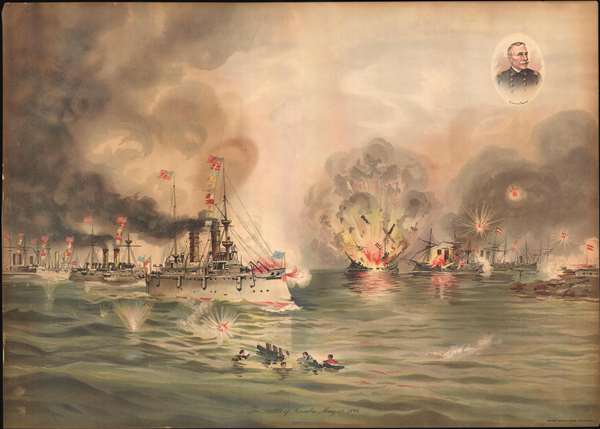
This item below is out of stock, but another example (left) is available. To view the available item, click "Details."
Details
1898 Xanthus Russell Smith View of the Battle of Manila, the Philippines
1898 (dated) $900.00
1898 Xanthus Russell Smith View of the Battle of Manila, the Philippines
BattleofManila-xanthussmith-1898
Title
1898 (dated) 20 x 28 in (50.8 x 71.12 cm)
Description
The American Asiatic Squadron under Commodore George Dewey engaged and destroyed the Spanish Pacific Squadron under Admiral Patricio Montojo. At 5:41 AM, with the now famous command, 'You may fire when ready, Mr. Gridley,' Commodore Dewey instructed Olympia's Captain to begin the bombardment of the Spanish fleet. After a furious exchange of fire, Captain Gridley messaged Dewey that only 15 rounds ammunition remained per gun. Concerned, Dewey ordered an immediate withdraw. So as not to alarm the crew, he announced that they were 'pausing for breakfast' – which they proceeded to enjoy. During this historic 'breakfast' it became apparent that the communication has gone awry and that the actual message was that Gridley has 'expended only 15 rounds of ammunition per gun.' The Battle commenced at 10:40 AM and followed with the surrender and total destruction of the Spanish squadron. The Spanish colors were struck at 12:40 PM.
This view was painted by Xanthus Russell Smith in 1898, shortly after the battle itself. A portrait of Dewey appears in the upper right. This chromolithograph view of the battle was printed by Joseph Hoover and Son. Joseph Hoover also released a similar view by Xanthus Russell Smith of the Battle of Santiago, the other major naval engagement of the Spanish American War.
CartographerS
Xanthus Russell Smith (February 26, 1839 – December 2, 1929) was an American painter and illustrator known for his war images. Smith was born in Philadelphia, the son of known painters William Thompson Russell Smith and Mary Priscilla Wilson. He was home schooled as an artist. As a young man, he studied chemistry at the University of Pennsylvania before transferring to the Pennsylvania Academy of Fine Arts. During the Civil War, he served in the Union Navy, and was part of the blockade of Charleston. While there was little action in this post, it did give him the opportunity to master maritime seascapes. He produced several important images of the Civil War – it is for these that he is best known today. After the war he married Mary Binder, the wealthy daughter of a Philadelphia lumber magnate. They retired to raise their family at a suburban villa in Glenside, Pennsylvania, called 'Edgehill.' Smith continued to paint until his death at 90, enjoying some commercial success. More by this mapmaker...
Joseph Hoover (December 29, 1830 - August 7, 1913) was an American lithographer and chromolithographer active in the second half of the 19th century. Born in Baltimore, Hoover was of Swiss-German descent. He moved to Philadelphia in 1856, establishing himself as a wood-turner and frame maker. Around the same time, he also began issuing lithograph parlor prints in order to increase his framing business. In the 1860s he embraced the new technology of chromolithography, a system for printing color images. He was one of only three American lithographers honored at the Philadelphia Centennial Exhibition of 1876. The business became wildly successfully. By the late 1880s he was issuing 600,000 – 700,000 chromolithographs a year, becoming one of the largest publishers of art prints in the United States. Hoover's older son, Henry L. Hoover, joined the business sometime in the late 19th century. His younger son Joseph W. Hoover, followed in 1904. Hoover died in Atlantic City if heart failure in 1913. The firm continued to operate in the Hoover family until about 1985. Learn More...

